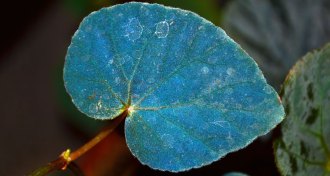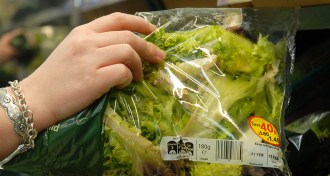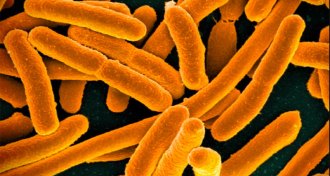Notebook
-
 Health & Medicine
Health & MedicinePenicillin allergy? Think again.
Most people are either mislabeled with a penicillin allergy or get over it with time, and doctors don’t always think to check.
-
 Health & Medicine
Health & MedicineOldest traces of smallpox virus found in child mummy
The oldest genetic evidence of smallpox comes from variola virus DNA found in a child mummy buried in a church crypt in Lithuania.
By Meghan Rosen -
 Animals
AnimalsWhy crested penguins lay mismatched eggs
After long migratory swims, crested penguins lay one small and one larger egg.
By Susan Milius -
 Astronomy
AstronomyGaggle of stars get official names
The names of 227 stars have been formally recognized by the International Astronomical Union.
-
 Life
LifeBlue leaves help begonias harvest energy in low light
The iridescent color of some begonias comes from tiny structures that also help the plant convert dim light into energy.
-
 Microbes
MicrobesCut leaves in bagged salads help Salmonella grow
Juice from torn-up leafy greens helps Salmonella spread in bagged salads.
-
 Life
LifeTiny toxic proteins help gut bacteria defeat rivals
A strain of E. coli makes competition-killing tiny proteins and soothes inflamed intestines.
-
 Earth
Earth50 years ago, nuclear blasting for gas boomed. Today it’s a bust.
50 years ago, scientists made plans to use nuclear explosions to extract natural gas from underground. In one such experiment, the gas was released but turned out to be radioactive.
-
 Health & Medicine
Health & MedicineA Pap smear can scoop up fetal cells for genome testing
Pap smear during pregnancy could offer an early way to test for fetal genetic disorders.
By Meghan Rosen -
 Animals
AnimalsBrazilian free-tailed bats are the fastest fliers
Ultrafast flying by one bat species leaves birds in the dust.
-
 Animals
AnimalsAn echidna’s to-do list: Sleep. Eat. Dig up Australia.
Short-beaked echidna’s to-do list looks good for a continent losing other digging mammals.
By Susan Milius -
 Health & Medicine
Health & Medicine50 years ago, fluoridation was promoted as a bone protector
In 1966, scientists hoped fluoride might protect adult bone health. While the results broke down over time, the benefits for teeth remain clear.